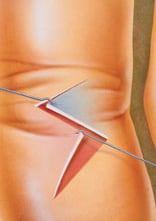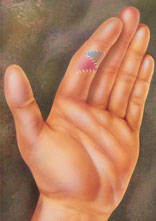How Scar Revision Works
During surgery, skin tissue is strategically removed from the scar and surrounding area in a specific shape or pattern that aids in diminishing the size of the original scar.
For scars that are too large to be revised in one procedure, and that lack sufficient skin for a local skin flap, partial or serial excisions may be selected. During these procedures, an area of tissue shaped like an ellipse is excised from the scar’s center, and the sides of wound are undermined for closure.Z-plasty and W-plasty prove to be successful approaches to contractures because they work to reposition the scars along the natural lines of the skin, making them less visible. Dr. Goldberg conducts a Z-plasty by making a Z-shaped incision with the middle line running along the scar tissue. The flaps of skin formed by the other lines of the Z are then rotated, repositioning the scar about 90 degrees, and thereby breaking up the straight line of the scar into smaller units.In a similar manner, the W-plasty diminishes the scar appearance by turning a straight line into an asymmetrical one, but without the formation and repositioning of skin flaps. Here, Dr. Goldberg makes a series of short incisions, forming a zigzag pattern to replace the straight line of the scar.These illustrations depict how scars can be removed via a Z-plasty procedure.
-

-
Scars can form contractures that restrict finger motion.
-

-
The scar is removed with Z-plasty and several incisions are made on each side, which create small triangular skin flaps. The flaps are rearranged and interlocked to cover the affected area.
-

-
Dr. Goldberg closes the incision with a Z-shaped line of sutures. The new scar is thinner and less visible, and allows the finger to be extended.
After Scar Revision
Some scar revision treatments are best cared for with pain medication, rest, and wound and bandage care. If skin grafts or flaps are used, postoperative care will begin in the hospital. Dr. Goldberg may recommend follow-up sessions to determine the success of the surgery and your recovery.
For more information about scar revision, call our office for a consultation at 914-722-1600.


